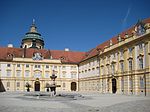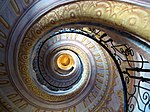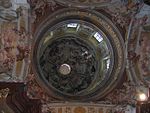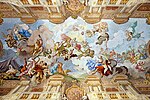Stift Melk
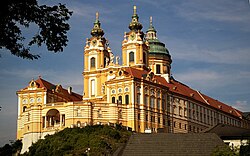
Stift Melk är ett benediktinkloster ovanför staden Melk, Niederösterreich, Österrike, på en klippa med utsikt mot floden Donau, i anslutning till dalgången Wachau.[1] Klostret innehåller helgonet Sankt Kolomans grav och även kvarlevorna av ett flertal medlemmar av huset Babenberg, Österrikes första styrande dynasti[2]. Slottet grundades 1089 av Leopold II av Babenberg och hans hustru Ida.
Dagens klosterbyggnad uppfördes mellan 1702 och 1736 efter ritningar av Jakob Prandtauer. I klosterkyrkan finns fresker utförda av Johann Michael Rottmayr.
Galleri
- Stift Melk
- Huvudingång
- Prelatens borggård
- Stift Melk på natten
- Stift Melk på natten från den gamla staden
- Bild ovanifrån
- Leopold Altar, målning av Georg Bachman (1650)
- Korstolar
- Predikstol
- Takfresker
- Melks bibliotek
- Trappa mellan biblioteket och kyrkan
- Klosterkyrkan
- Tak med fresker i kyrkan
- Kupol
- (c) I, Alberto Fernandez Fernandez, CC BY 2.5Munkens triumf, av Johann Michael Rottmayr
- Stift Melk
- Stift Melk
- Margravine Swanhildes altare, 1200-talet
- (c) I, Alberto Fernandez Fernandez, CC BY 2.5St. Benedicts jublande uppstigande till himlen, även den av Rottmayr
- (c) I, Alberto Fernandez Fernandez, CC BY 2.5Takmålning i marmorhallen
- Stift Melk år 1672, innan det renoverades av Jakob Prandtauer.
Referenser
- ^ ”Benediktinerstift Melk” (på tyska). 2016. http://austria-forum.org/af/AEIOU/Benediktinerstift_Melk. Läst 1 juni 2016.
- ^ Ellegast, Dr. Burkhard (1998). Melk Abbey. Melk: Stift Melk. sid. 51
- Den här artikeln är helt eller delvis baserad på material från engelskspråkiga Wikipedia, 1 juni 2016.
Media som används på denna webbplats
Författare/Upphovsman: Aconcagua, Licens: CC BY-SA 3.0
Melk Abbey, Lower Austria, staircase between library and church
Författare/Upphovsman: Aconcagua, Licens: CC BY-SA 3.0
Melk Abbey, Lower Austria, main entrance
Författare/Upphovsman: Aconcagua, Licens: CC BY-SA 3.0
Melk Abbey, Lower Austria
Författare/Upphovsman: The original uploader was HochauerW på engelska Wikipedia., Licens: CC BY-SA 2.0
Photo W. Hochauer, Stift Melk, Lower Austria, This photo is from Abbey Melk, April 2005 from Walter Hochauer [1]
en:Melk Abbey (de:Stift Melk) before its renovation by Jakob Prandtauer.
The pulpit in the church of Melk Abbey
Författare/Upphovsman: de:Benutzer:AlterVista, Licens: CC BY-SA 3.0
Stift Melk über der Melker Altstadt
Författare/Upphovsman: Mussklprozz, Licens: CC BY-SA 3.0
Stift Melk, Austria, frescos on the ceiling of the church, by the artist de:Johann Michael Rottmayr
(c) I, Alberto Fernandez Fernandez, CC BY 2.5
- Ceiling fresco representing the St. Benedict's triumphal ascent to heaven by Johann Michael Rottmayr (1721) - Melk Abbey (Austria) [1]
- Representation of battle for virtue of a monk depicted of St. Benedict.
Författare/Upphovsman: Carsten Steger, Licens: CC BY-SA 4.0
Aerial image of the Melk Abbey and its park (view from the southwest)
Författare/Upphovsman: Aconcagua, Licens: CC BY-SA 3.0
Melk Abbey, Lower Austria, prelate's courtyard
Melk Abbey. Melk Abbey, Melk.
Författare/Upphovsman: Georges Jansoone, Licens: CC BY 2.5
Portable Altar of Margravine Swanhilde (mid 11th c.); museum of the Melk Abbey, Austria
Författare/Upphovsman: Uoaei1, Licens: CC BY-SA 3.0 at
Frescos of dome and ceiling in Melk Abbey Church by Johann Michael Rottmayr (1716-22)
(c) I, Alberto Fernandez Fernandez, CC BY 2.5
detalj
Författare/Upphovsman: C.Stadler/Bwag, Licens: CC BY-SA 4.0
West view of Melk Abbey, Lower Austria.
Författare/Upphovsman: Georges Jansoone, Licens: CC BY 2.5
Leopold altar; painting by Georg Bachman (1650); church of the Melk Abbey, Austria
The choir stalls in the church of Melk Abbey
Melk Benedictine Abbey Library
(c) I, Alberto Fernandez Fernandez, CC BY 2.5
Författare/Upphovsman: Mussklprozz, Licens: CC BY-SA 3.0
Stift Melk, Austria, cupola


